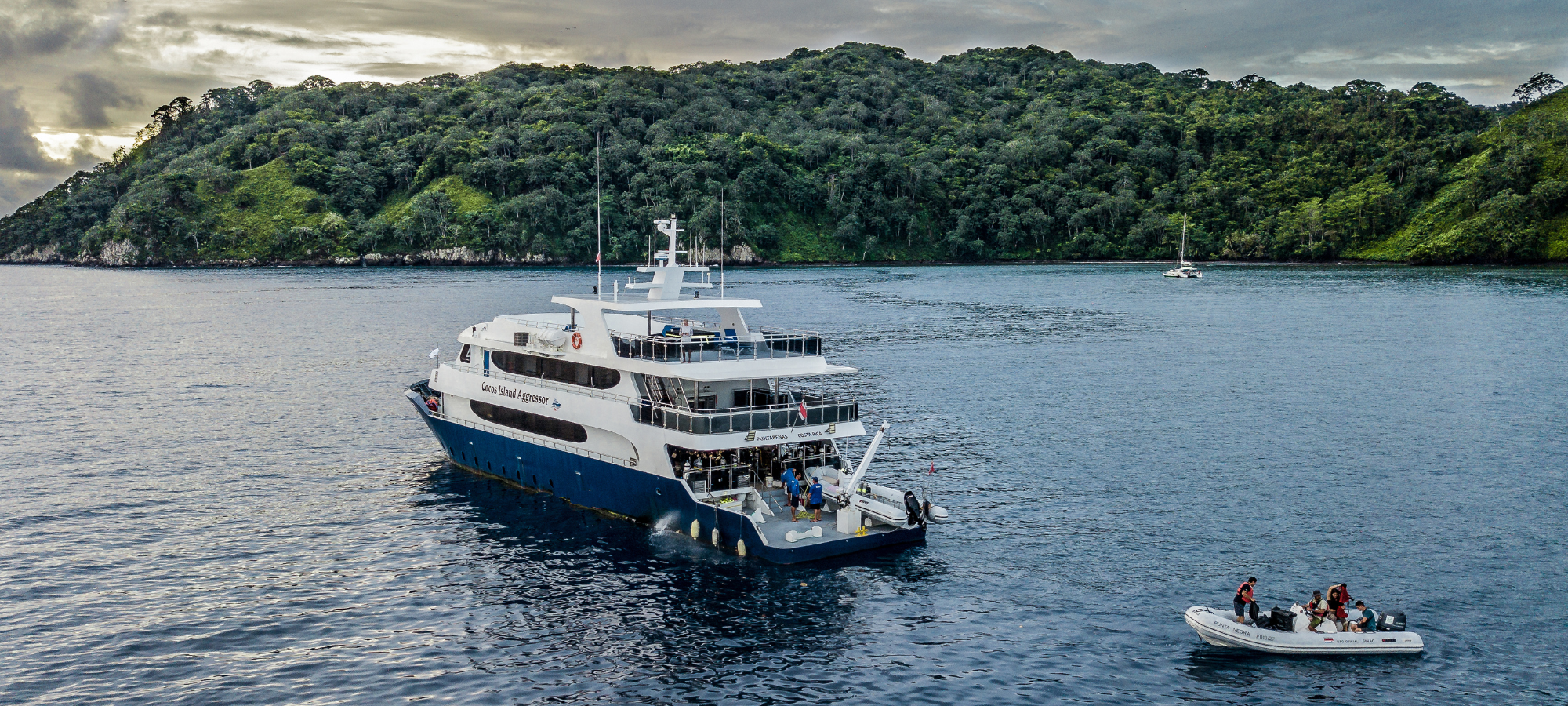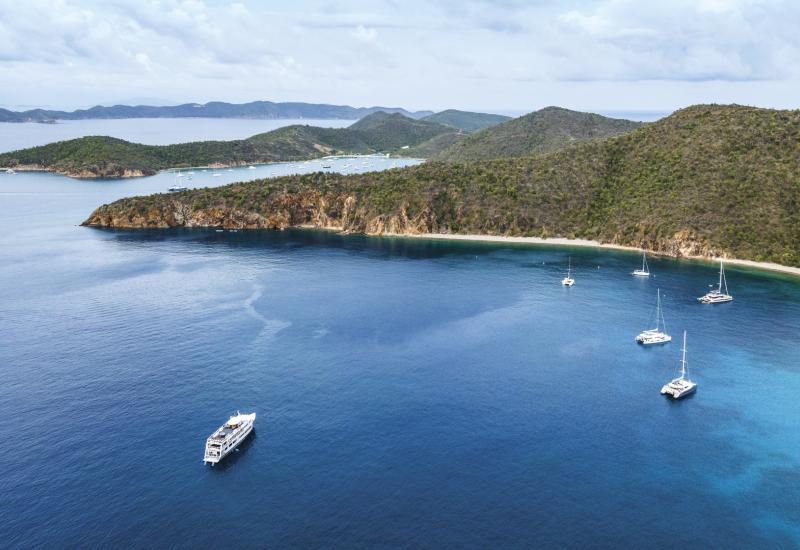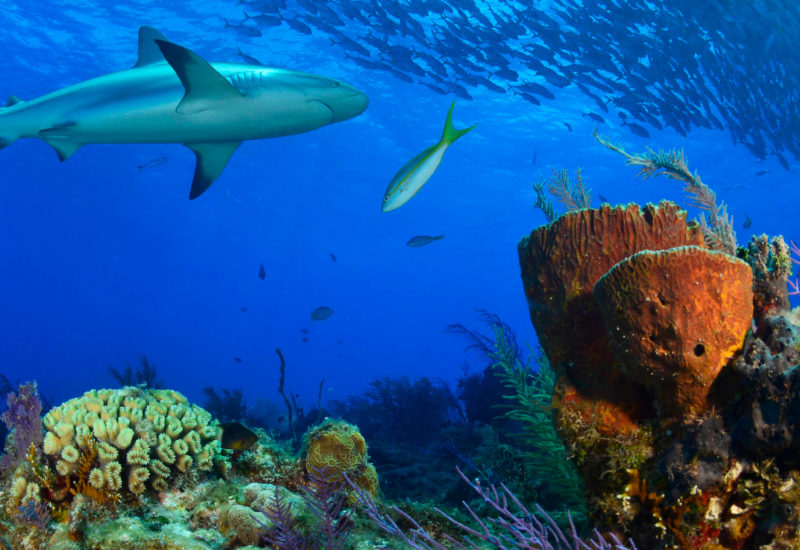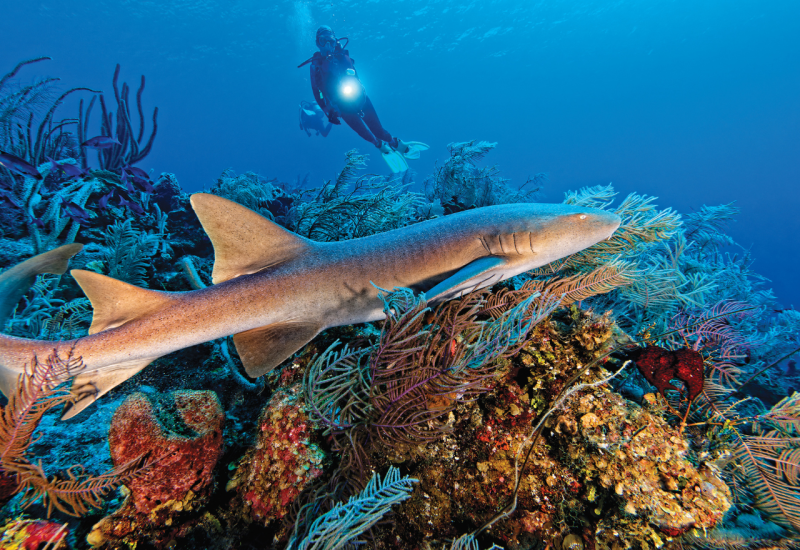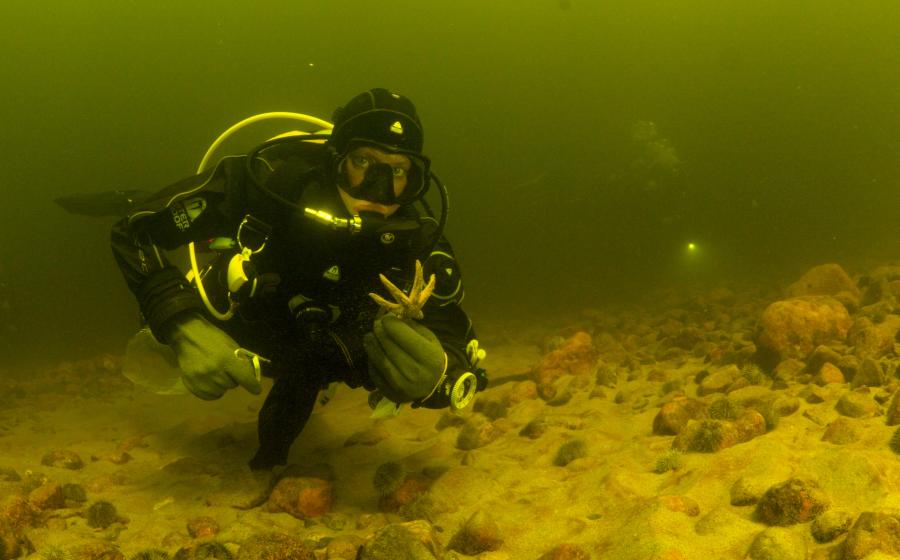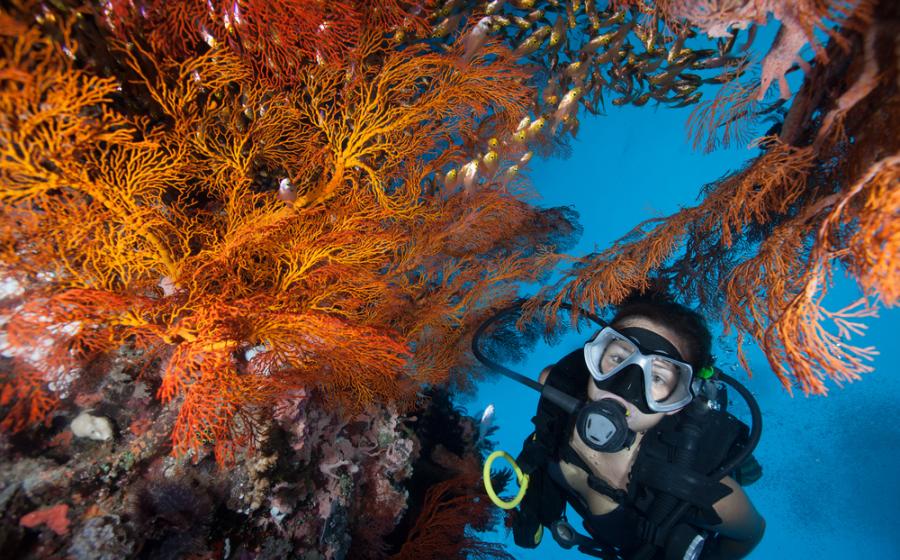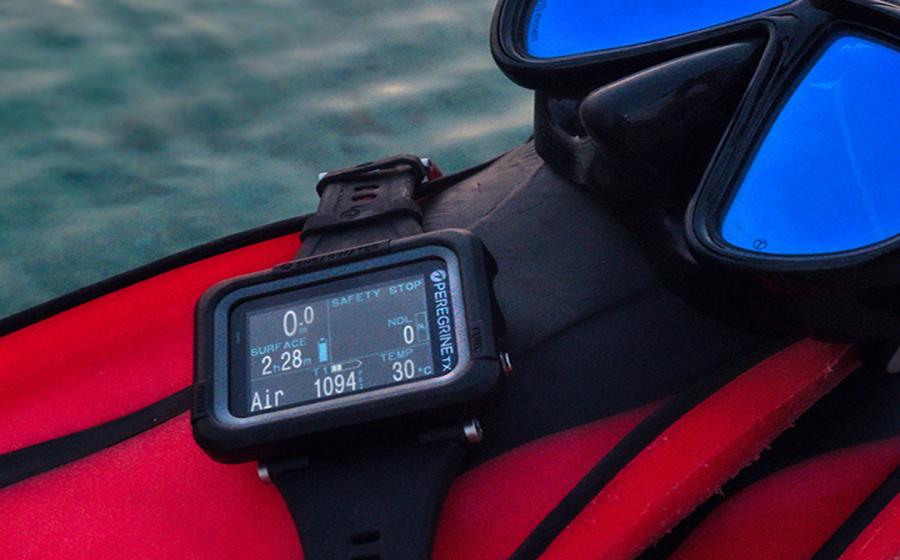Treasure Island!
A waning moon, playing peek-a-boo behind high clouds, greeted our 3 a.m. arrival into Chatham Bay. Working quickly, the staff attached our liveaboard yacht, the Cocos Island Aggressor, to a permanent mooring. Our arrival to Chatham Bay, a protected anchorage at Cocos Island, seemed covert as we arrived in the dead of night.
Treasure Island, the romantic sobriquet for Cocos Island, comes from its reported several billion dollars’ worth of hidden treasure accrued during multiple pirate campaigns on the high seas. And while scores of treasure hunters have scoured the island for centuries, Cocos Island has yet to yield any of her supposed loot.
I am awake on deck, but I am uninterested in the island’s alleged pirate spoils. Rather, I am contemplating the marine treasure we hope to find beneath the island’s waves, beginning just after first light.
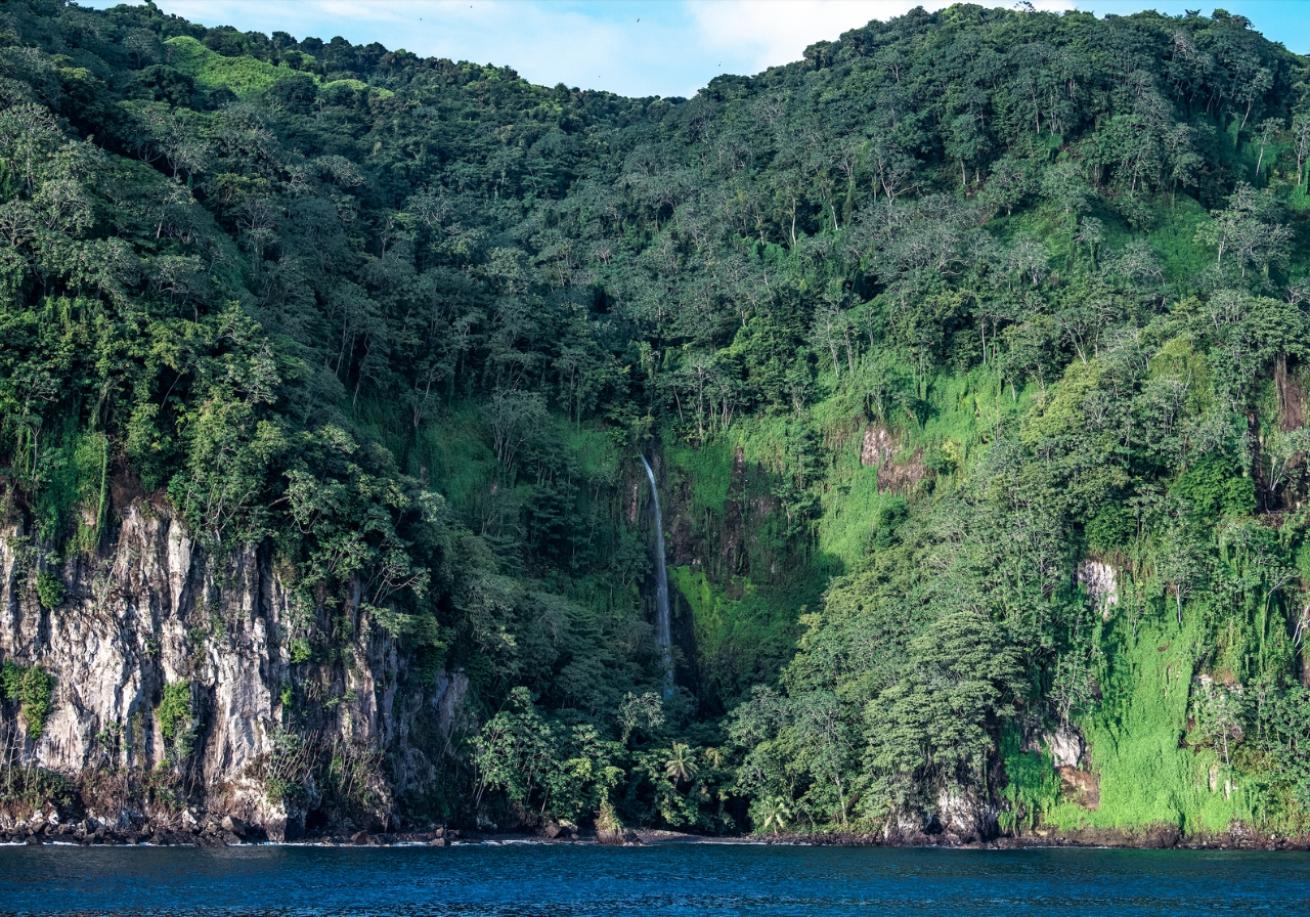
Mark HatterThe uninhabited island is renowned for its lush tropical rainforests, dramatic rock formations, cascading waterfalls, and, of course, its diverse marine life.
Cocos Island is a geological wonder some 300 miles off the southwest coast of Costa Rica’s Pacific coastline. With both volcanic and tectonic origins, the 9-square-mile island is one of the wettest places on earth (averaging 23 feet of rain a year in the central cloud forest) and the only rainforest island in the tropical eastern Pacific.
Below the surface, Cocos Island’s uniqueness continues. Washed by the north equatorial countercurrent, the island is the beneficiary of species recruitment from the western Pacific and shares many of the same species found in this swath of ocean, but its isolation also results in a few strictly endemic marine life forms.
Mark HatterEvery moment at Cocos Island is a thrilling journey into the heart of nature’s beauty.
Indeed, it’s Cocos Island’s unique fauna and flora that resulted in the island’s designation as a Costa Rican National Park in 1978 and as a coveted UNESCO World Heritage Site in 1997. Because of Cocos Island’s special significance, in 2002, the WHS boundaries were extended beyond the island to now include a 771-square-mile marine zone.
In 2022, Ecuadorean President Guillermo Lasso announced the expansion of the Galápagos Marine Reserve by adding 23,000 square miles of additional protection for submarine mountains northeast of the Galapagos. Known as the Hermandad Marine Reserve, it connects with the protected area around Cocos Island. Cocos Island has demonstrated benefit from the added protection as evidenced by flourishing populations of schooling fish and apex predators.
Famed oceanographer Jacques Cousteau visited the island several times at the end of the last century. Cousteau called Cocos “the most beautiful island in the world.” In the decades since, I wondered whether Cocos Island would present itself to the explorers onboard the Cocos Island Aggressor as the most beautiful island in the world, Would the Island’s collective protective designations yield substantial marine treasures? And would Cocos Island, voted by PADI as one of the top 10 diving destinations on the planet, live up to its hype?
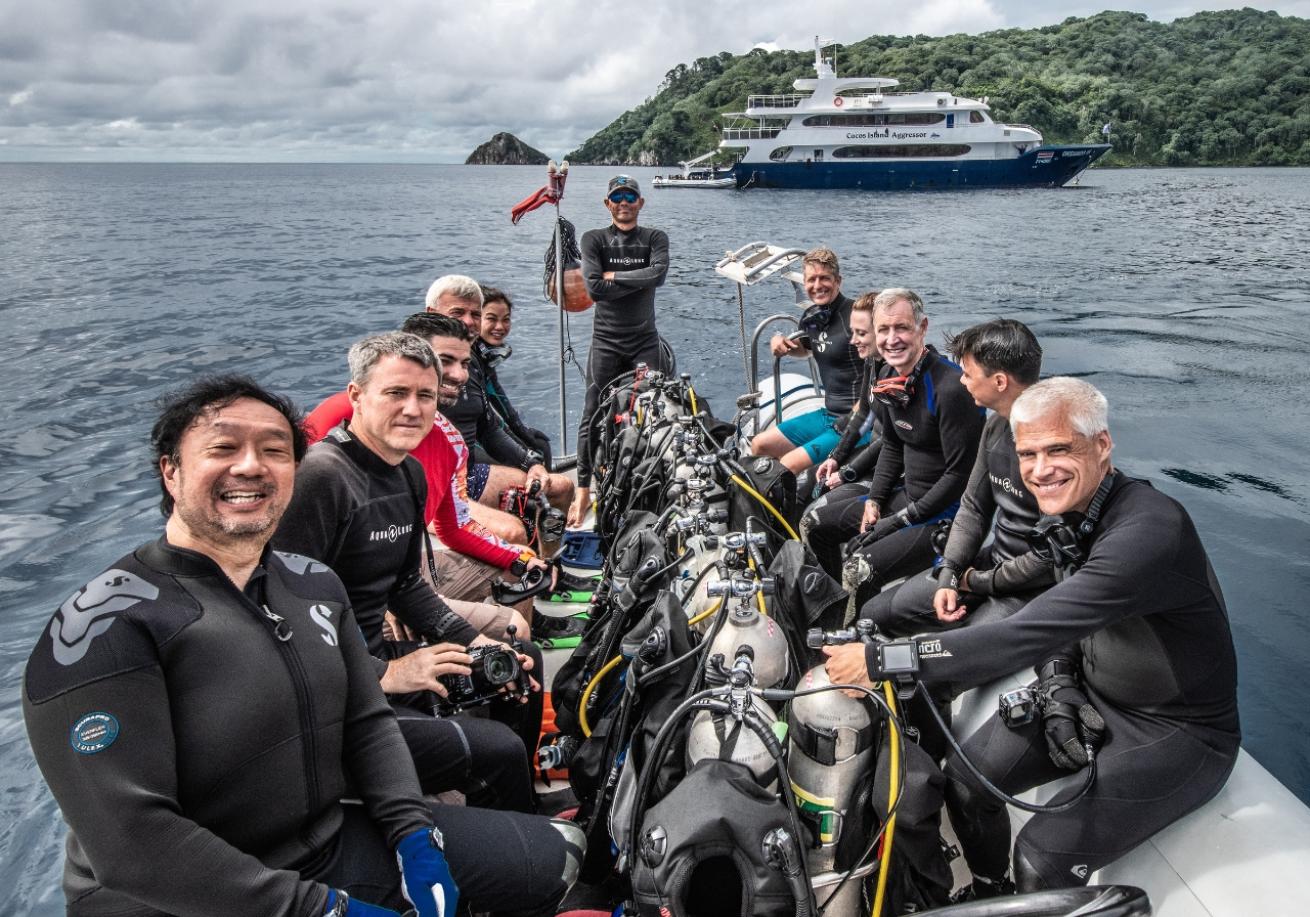
Mark HatterCocos Island Aggressor divers eagerly awaiting the opportunity to explore the hidden treasures awaiting them beneath the surface.
During the morning’s dive briefing I was not expecting much, especially on “just a checkout dive,” at a site named Manuelita Coral Gardens. After all, we were at the farthest reaches of the eastern Pacific Ocean, 11,000 miles from the heart of the “Coral Triangle.” Upon rolling into super clear water from our inflatable panga, only two minutes from the Cocos Island Aggressor mooring, I was gobsmacked! A spectacular coral garden stretched from the shallows in the lee of Manuelita Island to a depth of around 60 feet where the reef sloped into a sandy plane.
To be sure, the diversity of reef-building corals is limited at Cocos with just nine species represented. However, what it may lack in species diversity is more than made up for by quantity and quality of its reef corals. Manuelita Coral Gardens also flourished with fish! Schools of blue and gold snappers, close cousins to the western Pacific blue lined snapper, were everywhere.
On the reef I encountered toothy triggerfish, brightly colored wrasse flitting between coral heads, endemic damselfish guarding small patches of reef, small grouper and blood-red soldierfish peering from overhangs and, omnipresent surgeonfish grazing on rocks. Only minutes into the first dive, I had already found some of Cocos Island’s natural treasure. Most of the divers who come to Cocos are eager to have encounters with the large number of sharks species for which the island is famous, rather than for its coral reefs. For me, the beautiful coral reef was a surprising bonus.
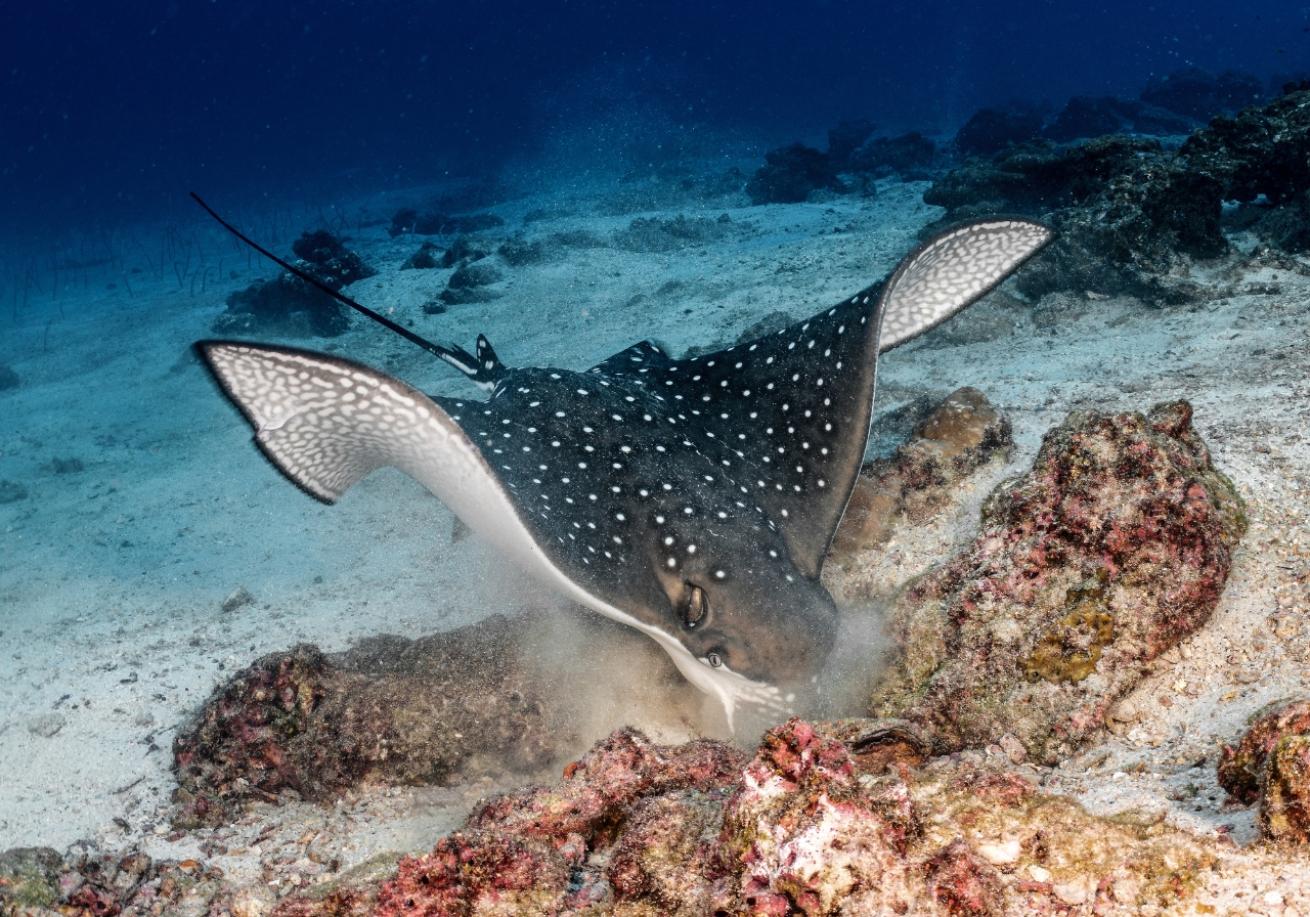
Mark HatterThe cleaning stations at Cocos Island serve as magnets for large marine animals and thrilling encounters, as they congregate to maintain their health and hygiene.
Cleaning stations are the key to encountering large, oceanic animals such as sharks and rays. Cocos Island’s marine topography, which typically drops abruptly to deep water from just off the main island, or its smaller islets (such as Manuelita Island), enables the establishment of significant, deep cleaning stations at several locations around Cocos’ periphery.
Perfectly situated at the boundary between Cocos Island’s tropical surface water (80 degrees on average) and the cooler deep water (75 degrees on average) preferred by scalloped hammerhead sharks, Galapagos sharks, silky sharks and others, the cleaning stations are an essential part of the shark’s hygiene for health. King angelfish, barberfish and to a lesser degree, juvenile fish of a few different species, welcome the sharks and rays at certain locations for an easy meal of skin parasites. In exchange, the sharks and rays are able to rid themselves from pesky parasites.
There are two iconic cleaning station sites at Cocos where most of the schooling hammerhead action occurs when conditions are right; Bajo Alcyone and Dirty Rock. “Right conditions” include a strong current and a thermocline, where tropical surface water gives way to cooler, deep ocean water, upwelling from beyond the Cocos tectonic plate.
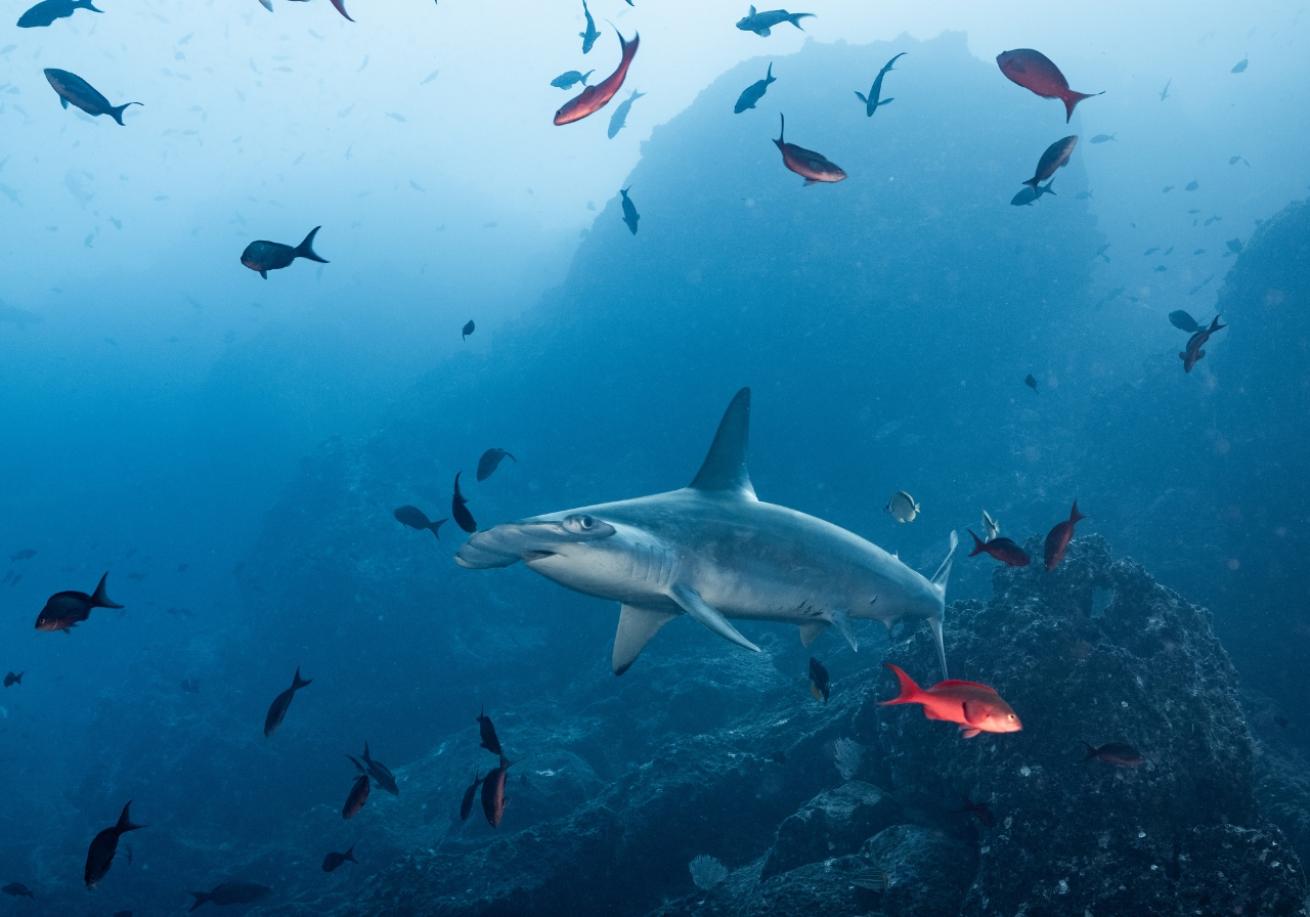
Mark HatterThe cleaning stations are the perfect stage for divers to watch nature’s “time-out” between predator and prey for a brief act of mutual benefit.
At Dirty Rock, the north facing wall drops from the surface to a sandy shelf at around 110 feet where cleaning typically takes place. Cleaning can occur higher or lower on the wall, generally correlating with the depth of the thermocline.
Interestingly, much of the schooling hammerhead shark encounters occur in blue water near the cleaning stations. Curious and plentiful, the sharks will often materialize out of nowhere for a drive-by. How close a diver might get is the luck of the draw and is influenced, again, by water temperature. Cooler water increases the likelihood of encountering hammerheads and if the cool water is shallow, you can expect sharks to follow.
At Cocos Island, just when you think you are finished hunting, natural treasure can sometimes be found hiding in plain sight. Such was the case on our first ascent from the cleaning station at Dirty Rock. Our dive guide led us to the largest school of bigeye jacks I’ve encountered. The jacks are apparently almost always found off Dirty Rock, circling slowly at around 40 feet, in blue water off the western tip of the rock. The jacks easily numbered in the thousands and provided our divers an epic photo shoot on the multiple dives we completed at Dirty Rock over the course of a week.
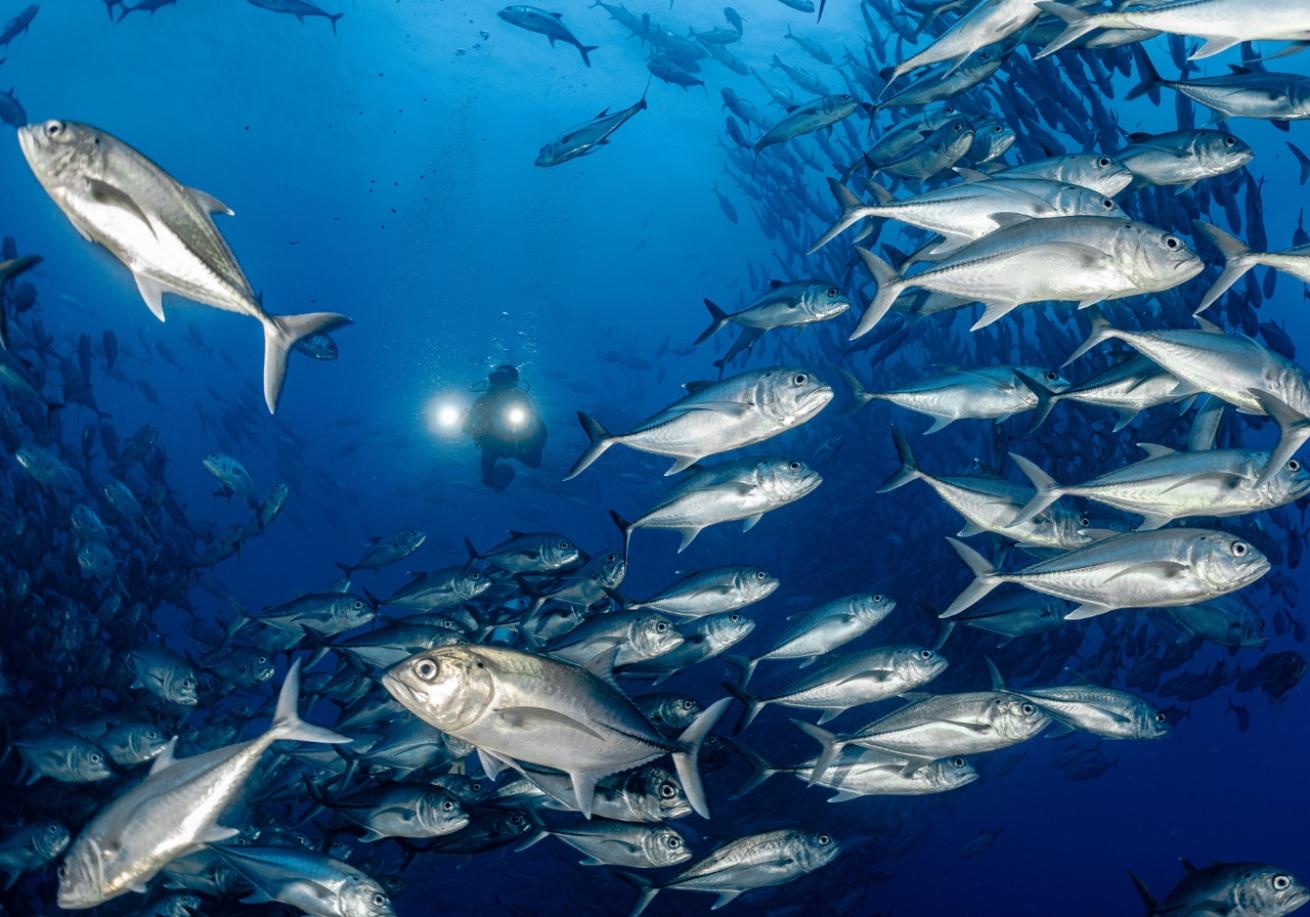
Mark HatterThe fun never stops. As divers ascend from the thrill of Dirty Rock, they're surrounded by a mesmerizing spectacle: thousands of bigeye jacks swirling around them, creating an enchanting underwater ballet.
For an encounter with the less common Galapagos shark, another cleaning station on the southwest side of Cocos, Dos Amigos Poquino, provides an opportunity. It’s the middle of the week, it’s raining (no surprise here at Cocos) and the wind is whipping the tops off of an oceanic swell as we take a wet rollercoaster ride down the windward side of Cocos. The inflatable panga takes the sea in stride and, ensconced in neoprene, we remain quite comfortable riding on the soft pontoons, our tanks secured in a center rack on the panga’s floor.
Arriving a Dos Amigos, we roll into stunning visibility, gliding down the rocky slope, riding a gentle current to around 90 feet. I dip below the transition layer to a dark ethereal world of streaming blue and gold snappers, numbering in the hundreds, another 10 feet below me. A 12-foot Galapagos shark with a squadron of jacks suddenly materializes into plain view.
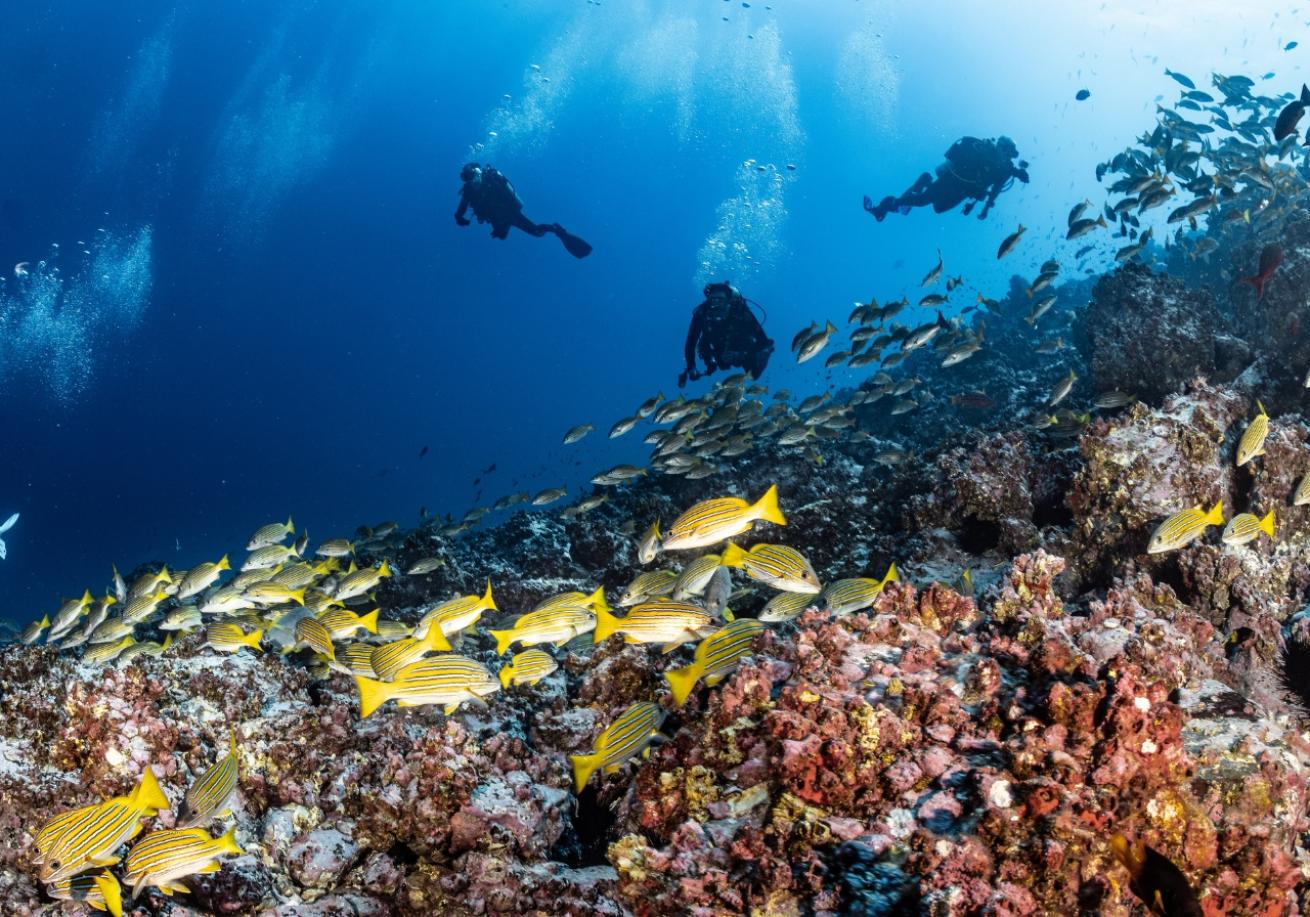
Mark HatterDivers explore the stunning underwater landscape of Dos Amigos, boasting a 45-foot-high arch and 60-foot pinnacle off the southeast side. Encounter an array of marine life, from Rainbow Runners, Yellowtail Snapper, Hammerheads, and the occasional Galapagos shark.
Some days, found treasure is gold bullion; some days, it’s silver coins. At Dos Amigos, we find a gem in a 12-foot Galapagos shark.
At week’s end, it’s apparent that Jacques Cousteau’s proclamation of Cocos’ beauty was no hyperbole. We had arrived in the dead of night, in search of natural riches on a remote island with a nickname derived from its rumored buried treasure worth billions. Now, as we depart for home during the light of day, we are considerably richer for having journeyed here.
LEARN MORE
Reservations: Aggressor Adventures LLC
aggressor.com, [email protected], 800-348-2628, +1-706-993-2531
SAVE 25% - EXPLORE THE WORLD WEEKS
Guests will receive 25% off Explore the World weeks. These are scheduled weeks chosen throughout the year that are scheduled on all Aggressors. New weeks are added from time to time so keep checking back. (Group payment policy not available for group rsv on Explore the World Weeks)
Mar 27 - Apr 6 Okeanos Aggressor II
Apr 19 - 29 Cocos Island Aggressor

